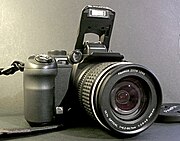Digital single lens reflex cameras
Digital single-lens reflex cameras (DSLRs) are digital cameras based on film single-lens reflex cameras (SLRs), both types are characterized by the existence of a mirror and reflex system. See the main article on DSLRs for a detailed treatment of this category.
Digital rangefinders
A rangefinder is a user-operated optical mechanism to measure subject distance once widely used on film cameras. Most digital cameras measure subject distance automatically using acoustic or electronic techniques, but it is not customary to say that they have a rangefinder. The term rangefinder alone is sometimes used to mean a rangefinder camera, that is, a film camera equipped with a rangefinder, as distinct from an SLR or a simple camera with no way to measure distance.
Information on digital rangefinder cameras specifically is here.
Professional modular digital camera systems
This category includes very high end professional equipment that can be assembled from modular components (winders, grips, lenses, etc.) to suit particular purposes. Common brands include Hasselblad and Mamiya. They were developed for medium or large format film sizes, as these captured greater detail and could be enlarged more than 35 mm.
Typically these cameras are used in studios for commercial production; being bulky and awkward to carry they are rarely used in action or nature photography. They can often be converted into either film or digital use by changing out the back part of the unit, hence the use of terms such as a "digital back" or "film back". These cameras are very expensive (up to $40,000) and are typically not used by consumers.






